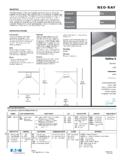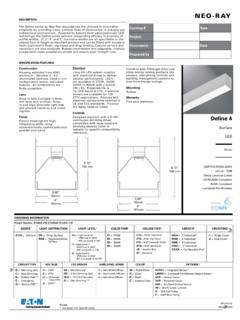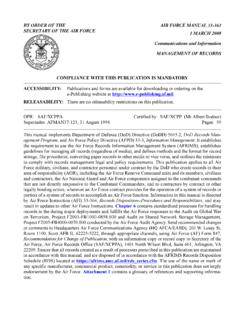Transcription of Program Associated Data Deployment at Wisconsin Public …
1 Program Associated data Deployment at Wisconsin Public Radio Steve Johnston and Kevin Trueblood Wisconsin Public Radio Madison, Wisconsin Abstract - This paper describes the roll-out of Program Some emerging technologies stimulated WPR's interest: Associated data service at Wisconsin Public Radio. Program Associated data (PAD), also known as Program FM RDS/RBDS. Service data (PSD), is the metadata related to the audio HD Radio on AM and FM stations programming generated for display on the front panels of Internet audio players FM RDS/RBDS receivers, HD Radios, web players, and other consumer devices. A 33-station, three-network RDS/RBDS allowed FM stations to display station operation, WPR's implementation of PAD is more identification, slogans, and basic Program information.
2 Challenging than a typical stand-alone music station Deployment of HD Radio on AM and FM stations brought cranking out the hits. WPR airs programs from a wide basic identification and format display information. variety of live, recorded, network, and remote sources Likewise, new internet audio players with metadata display running on a complex array of radio stations that come and capabilities came on the scene. These technologies whetted go from the network at varying times not to mention the appetite of listeners for more and better Program - multiple web as-playing pages and audio streams. Associated - data transmission. And these new technologies brought ways to make it happen. INTRODUCTION. Radio listeners have always enjoyed having some DEFINE THE PROBLEM.
3 Background information about the programs they are hearing. Traditionally this could be a Top-40 disk-jockey Albert Einstein once said that if he had one hour to save the fast-talking his way through the last few song titles and world he would spend fifty-five minutes defining the artists, or a jazz host reading album liners notes, or a talk problem and only five minutes finding the solution. show host telling you more about the guest in the studio. Wisconsin Public Radio is a statewide radio service But announced information is easy to miss for one with 3-networks airing on 33-stations and 9 web streams. reason or another, such as distractions ( Shut up I'm trying We would like PAD to be visible on FM receivers with RDS. to hear the radio! ) or tuning in after the show has already capability as well as AM/FM HD Radios.
4 We would also started ( What the heck is this show is about? ), or even too- like to provide similar information for listeners to our infrequent stations identifications ( Which station is this? ). internet audio services. To provide additional opportunities to get this The PAD data would include both static and dynamic information to the listeners, systems have been developed to information. display text and graphical information on the front panel of the receiver or computer screen (in the case of an internet Static PAD. audio player). This is called Program Associated data (PAD) or Program Service data (PSD). This PAD data can Callsign, frequency, slogan be both static (information related to the overall Program Wisconsin Public Radio . service) and dynamic (details of the particular Program Network Name element currently being broadcast).
5 Dynamic PAD. STIMULUS FOR ACTION. Beginning with early experiments with broadcasting in Current weather information 1917, Wisconsin Public Radio has a long tradition of Name of show on the air innovation [1], so Program Associated data was naturally Name of the host now on the air attractive. WPR listeners tend to be actively engaged in the Music title/composer/artists programming, often making contact to ask questions about Talkshow topic and guests what they have heard. Clearly providing additional Request and call-in numbers information along with the audio programming would be a Special pledge drive information helpful service for both radio and internet listeners. Emergency Alerts Figure 1. Complicating matters, WPR airs programs from a large number of live, recorded, network, and remote sources.
6 And GETTING STARTED. almost none of those sources presently has metadata available. Our live music shows are all hand-made Wisconsin Public Radio's first tentative steps in PAD used productions with hosts playing music from CDs. Music the tool we had purchased with our HD Radio systems: shows from outside network providers can only offer logs, Broadcast Electronics' product known as TRE The Radio no real-time data . NPR and other Public radio programs do Experience. [2] Using TRE we created a rotating schedule not as yet offer real-time metadata either. of static information to display on our flagship station, WPR uses Broadcast Electronics' AudioVault system WHA. This schedule transmitted items like WHA AM- for audio storage and playback at the Madison headquarters 970 , Wisconsin Public Radio , The Ideas Network , and and regional groups of stations.
7 AudioVault has metadata the name of the show scheduled to be on the air at that time, transmission capabilities, but this may not be much help such as The Larry Meiller Show . This worked well but it during live-assist conditions. was difficult to see how to expand operations to include And the final aspect of the problem: WPR programs air dynamic information. At about the same time, our web team on a variety of radio stations that come and go from the began to provide basic network PAD for display on user networks at times to broadcast their own regional and local audio player displays. Similar limitations arose when shows. There is no end to the fun since every station seems contemplating how to go beyond the static information. to be a special case !
8 For our live music shows how would we generate A key part of defining the problem was a series of dynamic title/composer/artist information? An electronic drawings we used to visually describe the flow of music log is prepared by our music department for each information for PAD at WPR. See Figure 1. show, presenting the possibility of harvesting the text about the music to be played. But clearly a way would be needed for the hosts to indicate when a particular piece of music had sent to all configured outputs but promotional messages, been started ( releasing the next song PAD to be weather forecast, etc may be blocked from any one or more displayed), as well as a mechanism for manual edits should outputs. deviation from the log be necessary. For talk shows, our producers already prepare show CSLogIt allow us to use our music scheduling software to notes which are a paragraph of information used to promote provide a daily playlist.
9 Since we use CDs during our live their upcoming shows both on the air and on the web. This music shows, this allows the host to easily indicate when a suggested there might be a way to gather up-to-date scheduled piece begins, releasing the data about the music information about show topics, hosts, and guests, but would into the PAD channels. A module was also created to require some changes in data entry to provide text that harvest Now Playing information from the satellite music would fit into the field restrictions present in the various source web playlist, and parses it to become PAD. display technologies. We would also need a way to information. manually enter data for specials. CSRAS is a Radio Automation Simulator that will send PAD data based on a pre-defined playlist.
10 If you are FINDING A VENDOR recording a live broadcast that will be re-broadcast at a later date and/or time, one can schedule the repeat broadcast As we considered these factors it seemed necessary to have using the CSScheduler module. At the desired date and time, our PAD organized at several levels network, regional, and the metadata provided during the original broadcast will be individual stations. We consulted with several PAD resent for the repeat broadcast. Different messages can also software vendors as to the costs we could expect for such an be used during the repeat broadcast. Similarly, if you are extensive installation the manner in which the companies delaying a live broadcast to be aired at the same time in chose to license their products was a big factor in the total another time zone, one could configure CSRAS to hold the project cost.






